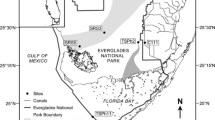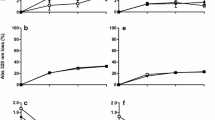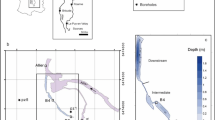Abstract
Microbial changes in selected operational descriptors of dissolved organic matters (DOMs) from nine different sources (treated sewage, algae, soils, sediment, plants), which include a broad spectrum of potential organic precursors in the Han River watershed, were investigated using 28-day microbial incubation experiments. The DOM descriptors investigated were specific UV absorbance, fluorescence index, humification index, synchronous fluorescence spectra, apparent molecular weight (MW), and the extent of pyrene binding. The UV absorbance and the humification index values of most DOM samples increased after incubation, and their increases were more pronounced for algal- and plant-derived DOM compared with other sources. Microbial changes in fluorescence index were not consistent for the DOM samples investigated. Irrespective of the DOM sources, microbial changes resulted in the enhancement of humic substance-like structures and the associated characteristics. Microbial utilization of biodegradable organic substances appears to be prerequisite for the enhancement. Algal-derived DOM exhibited a substantial enhancement in MW value, whereas little changes or even decreases in the MW values were observed for terrestrial sources of DOM. Pyrene-binding reactivity and the microbial enhancement were observed only for algal- and plant-derived DOM. Our results are expected to provide basis for better understanding downstream microbial changes in DOM and the subsequent impact on the binding capabilities of DOM for hydrophobic organic contaminants in watersheds.



Similar content being viewed by others
References
Aoki, S., Ohara, S., Kimura, K., Mizuguchi, H., Fuse, Y., & Yamada, E. (2008). Characterization of dissolved organic matter released from Microcystis aeruginosa. Analytical Sciences, 24, 289–394.
Baker, A. (2001). Fluorescence excitation-emission matrix characterization of some sewage-impacted rivers. Environmental Science & Technology, 35, 948–953.
Biers, E. J., Zepp, R. G., & Moran, M. A. (2007). The role of nitrogen in chromophoric and fluorescent dissolved organic matter formation. Marine Chemistry, 103, 46–60.
Chefetz, B., & Xing, B. (2009). Relative role of aliphatic and aromatic moieties as sorption domains for organic compounds: a review. Environmental Science & Technology, 43, 1680–1688.
Chen, J., LeBoef, E. J., Dai, S., & Gu, B. H. (2003a). Fluorescence spectroscopic studies of natural organic matter fractions. Chemosphere, 50, 639–647.
Chen, W., Westerhoff, P., Leenheer, J. A., & Booksh, K. (2003b). Fluorescence excitation- emission matrix regional integration to quantify spectra for dissolved organic matter. Environmental Science & Technology, 37, 5701–5710.
Chen, Z. Q., Hu, C. M., Comny, R. N., Muller-Karger, F., & Swarzenski, P. (2007). Colored dissolved organic matter in Tampa Bay, Florida. Marine Chemistry, 104, 98–109.
Chin, Y. P., Aiken, G. R., & Danielsen, K. M. (1997). Binding of pyrene to aquatic and commercial humic substances: the role of molecular weight and aromaticity. Environmental Science & Technology, 31, 1630–1635.
Fischer, H., Mille-Lindblom, C., Zwirnmann, E., & Tranvik, L. J. (2006). Contribution of fungi and bacteria to the formation of dissolved organic carbon from decaying common reed (Phragmites australis). Archiv Fur Hydrobiologie, 166, 79–97.
Fuentes, M., Gonzalez-Gaitano, G., & Ma Garcia-Mina, J. (2006). The usefulness of UV-visible and fluorescence spectroscopies to study the chemical nature of humic substances from soils and composts. Organic Geochemistry, 37, 1949–1959.
Gauthier, T. D., Shane, E. C., Guerin, W. F., Seitz, W. R., & Grant, C. L. (1986). Fluorescence quenching method for determining equilibrium constants for polycyclic aromatic hydrocarbons binding to dissolved humic materials. Environmental Science & Technology, 20, 1162–1166.
Helms, J. R., Stubbins, A., Ritchie, J. D., Minor, E. C., Kieber, D. J., & Mopper, K. (2008). Absorption spectral slopes and slope ratios as indicators of molecular weight, source, and photobleaching of chromophoric dissolved organic matter. Limnology and Oceanography, 53, 955–969.
Henderson, R. K., Baker, A., Parsons, S. A., & Jefferson, B. (2008). Characterisation of algogenic organic matter extracted from cyanobacteria, green algae and diatoms. Water Research, 42, 3455–3445.
Her, N., Amy, G., McKnight, D., Sohn, J., & Yoon, Y. (2003). Characterization of DOM as a function of MW by fluorescence EEM and HPLC-SEC using UVA, DOC, and fluorescence detection. Water Research, 37, 4295–4303.
Her, N., Amy, G., Park, H.-R., & Song, M. (2004). Characterizing algogenic organic matter (AOM) and evaluating associated NK membrane fouling. Water Research, 38, 1427–1438.
Hunt, J. F., & Ohno, T. (2007). Characterization of fresh and decomposed dissolved organic matter using excitation-emission matrix fluorescence spectroscopy and mutiway analysis. Journal of Agricultural and Food Chemistry, 55, 2121–2128.
Hur, J., & Kim, G. (2009). Comparison of the heterogeneity within bulk sediment humic substances from a stream and reservoir via selected operational descriptors. Chemosphere, 75, 483–490.
Hur, J., & Schlautman, M. A. (2003). Using selected operational descriptors to examine the heterogeneity within a bulk humic substance. Environmental Science & Technology, 37, 880–887.
Hur, J., Hwang, S.-J., & Shin, J.-K. (2008). Using synchronous fluorescence technique as a water quality monitoring tool for an urban river. Water, Air, and Soil Pollution, 191, 231–243.
Hur, J., Park, M.-H., & Schlautman, M. A. (2009a). Microbial transformation of dissolved leaf litter organic matter (OM) and its effects on selected OM operational descriptors. Environmental Science & Technology, 43, 2315–2321.
Hur, J., Lee, D.-H., & Shin, H.-S. (2009b). Comparison of the structural, spectroscopic, and phenanthrene binding characteristics of humic acids from soils and lake sediments. Organic Geochemistry, 40, 1091–1099.
Janhom, T., Wattanachira, S., & Pavasant, P. (2009). Characterization of brewery wastewater with spectrofluorometry analysis. Journal of Environmental Management, 90, 1184–1190.
Kalbitz, K., Schmerwitz, J., Schwesig, D., & Matzner, E. (2003). Biodegradation of soil-derived dissolved organic matter as related to its properties. Geoderma, 113, 273–291.
Kelton, N., Molot, L. A., & Dillon, P. J. (2007). Spectrofluorometric properties of dissolved organic matter from Central and Southern Ontario streams and the influence of iron and irradiation. Water Research, 41, 638–646.
Kim, J., Lee, S., Bang, H., & Hwang, S. (2009). Characteristics of algae occurrence in Lake Palang. Korean Journal of KSEE, 325–331. (in Korean)
Loiselle, S. A., Bracchini, L., Dattilo, A. M., Ricci, M., Tognazzi, A., Cózar, A., et al. (2009). Optical characterization of chromophoric dissolved organic matter using wavelength distribution of absorption spectral slopes. Limnology and Oceanography, 54, 590–597.
Maurice, P. A., Cabaniss, S. E., Drummond, J., & Ito, E. (2002). Hydrogeochemical controls on the variations in chemical characteristics of natural organic matter at a small freshwater wetland. Chemical Geology, 187, 59–77.
McKnight, D. M., Boyer, E. W., Westerhoff, P. K., Doran, P. T., Kulbe, T., & Andersen, D. T. (2001). Spectrofluorometric characterization of dissolved organic matter for indication of precursor organic material and aromaticity. Limnology and Oceanography, 46, 38–48.
Merritt, K. A., & Erich, M. S. (2003). Influence of organic matter decomposition on soluble carbon and its copper-binding capacity. Journal of Environmental Quality, 32, 2122–2131.
Minamikawa, K., & Sakai, N. (2007). Soil carbon budget in a single-cropping paddy field with rice straw application and water management based on soil redox potential. Soil Science & Plant Nutrition, 53, 657–667.
Negre, M., Vindrola, D., Spera, S., Ferraris, L., & Gennari, M. (2002). Effect of the chemical composition of soil humic acids on their viscosity, surface pressure, and morphology. Soil Science, 167, 636–651.
Perminova, I. R., Grechishcheva, N. Y., & Petrosyan, V. S. (1999). Relationships between structure and binding affinity of humic substances for polycyclic aromatic hydrocarbons: relevance of molecular descriptors. Environmental Science & Technology, 33, 3781–3787.
Rosario-Ortiz, F. L., Snyder, S. A., & Suffet, I. H. (2007). Characterization of dissolved organic matter in drinking water sources impacted by multiple tributaries. Water Research, 41, 4115–4128.
Saadi, I., Borisover, M., Armon, R., & Laor, Y. (2006). Monitoring of effluent DOM biodegradation using fluorescence, UV and DOC measurements. Chemosphere, 63, 530–539.
Sachse, A., Babenzien, D., Ginzel, G., Gelbrecht, J., & Steinberg, C. E. W. (2001). Characterization of dissolved organic carbon (DOC) in a dystrophic lake and an adjacent fen. Biogeochemistry, 54, 279–296.
Salloum, M. J., Chefetz, B., & Hatcher, P. G. (2002). Phenanthrene sorption by aliphatic-rich natural organic matter. Environmental Science & Technology, 36, 1953–1958.
Steinburg, C. E. W. (2003). Ecology of humic substances in freshwaters: determinants from geochemistry to ecological niches. New York: Springer.
Sun, L., Perdue, E. M., Meyer, J. L., & Weis, J. (1997). Use of elemental composition to predict bioavailability of dissolved organic matter in a Georgia river. Limnology and Oceanography, 42, 714–721.
Tanji, K. K., Gao, S., Scardaci, S. C., & Chow, A. T. (2003). Characterizing redox status of paddy soils with incorporated rice straw. Geoderma, 114, 333–353.
Thurman, E. M. (1985). Organic geochemistry of natural waters. Nordrecht, The Netherlands: Martinus Nijhoff/Junk Publisher.
Traversa, A., D'Orazio, V., & Senesi, N. (2008). Properties of dissolved organic matter in forest soils: Influence of different plant covering. Forest Ecology and Management, 256, 2018–2028.
Wickland, K. P., Neff, J. C., & Aiken, G. R. (2007). Dissolved organic carbon in Alaskan boreal forest: sources, chemical characteristics, and biodegradability. Ecosystems, 10, 1323–1340.
Zsolnay, A., Baigar, E., Jimenez, M., Steinweg, B., & Saccomandi, F. (1999). Differentiating with fluorescence spectroscopy the sources of dissolved organic matter in soils subjected to drying. Chemosphere, 38, 45–50.
Acknowledgments
This work was supported by National Research Foundation of Korea Grant funded by the Korean Government (No. 2009-0058569). I thank Min-Hye Park and Tae-Hwan Lee for their assistance in field sampling and chemical analyses.
Author information
Authors and Affiliations
Corresponding author
Rights and permissions
About this article
Cite this article
Hur, J. Microbial Changes in Selected Operational Descriptors of Dissolved Organic Matters From Various Sources in a Watershed. Water Air Soil Pollut 215, 465–476 (2011). https://doi.org/10.1007/s11270-010-0491-0
Received:
Accepted:
Published:
Issue Date:
DOI: https://doi.org/10.1007/s11270-010-0491-0




